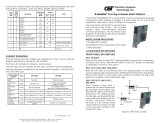Interface Module PTN-7-SERIAL 3
Release 03 05/2020
Contents
1. INTRODUCTION ......................................................................................................... 6
1.1 General ............................................................................................... 6
1.2 Manual References ............................................................................. 7
2. MODULE DESCRIPTION .............................................................................................. 8
2.1 Front Panel And Connection Kits ......................................................... 8
2.1.1 Insert/Remove Module into/from Node ................................................... 8
2.1.2 LEDs ............................................................................................................ 9
2.1.3 RJ.5 Connector ........................................................................................... 9
2.1.4 RJ.5 Cable ................................................................................................. 10
2.1.5 Connection Kits ........................................................................................ 10
2.1.6 Signals per Serial Port .............................................................................. 13
2.2 Functional Operation ........................................................................ 14
2.2.1 General .................................................................................................... 14
2.2.2 Service Combination Examples per IFM .................................................. 14
2.2.3 Port Interface Types ................................................................................ 16
2.2.4 Serial Port Role DTE/DCE ......................................................................... 16
2.2.5 Synchronization Parameter ..................................................................... 16
2.2.6 Pin Layout Parameter .............................................................................. 17
2.2.7 Services .................................................................................................... 17
2.2.8 CES: SAToP (Point-to-Point) ..................................................................... 18
2.2.9 CES: CESoPSN (Point-to-Point)................................................................. 18
2.2.10 CES: Hitless Switching .............................................................................. 18
2.2.11 CES: Single Path ....................................................................................... 19
2.2.12 Serial - SAToP: Mux/Demux to E1 on 4-E1-L IFM .................................... 20
2.2.13 ITU-T V.110 Standard ............................................................................... 21
2.2.14 CES: Delay Comparison in CES Features .................................................. 21
2.2.15 Serial Ethernet (Point-to-Multipoint) ...................................................... 22
2.2.16 Serial Ethernet: Master/Slave.................................................................. 22
2.2.17 Serial Ethernet: Advanced Mode - Bandwidth Optimization .................. 22
2.2.18 Serial Ethernet: Multidrop Consistency ................................................... 23
2.2.19 I/O with the Central Switching Module (=CSM) ...................................... 23
2.2.20 Synchronization / Clock Distribution / Network Timing .......................... 23
2.2.21 Test and Loopback Selftests .................................................................... 25
2.3 Onboard Interfaces ........................................................................... 26
2.3.1 Straps ....................................................................................................... 26
2.3.2 DIP Switches ............................................................................................ 26
3. TDM FRAMES/PACKET FOR CES ................................................................................ 27
3.1 General ............................................................................................. 27
3.2 Bandwidth ........................................................................................ 27
3.3 Delay ................................................................................................ 28
3.3.1 General .................................................................................................... 28
3.3.2 Delay Parameters .................................................................................... 28
3.3.3 Estimated Delay Calculation and Formulas ............................................. 29























